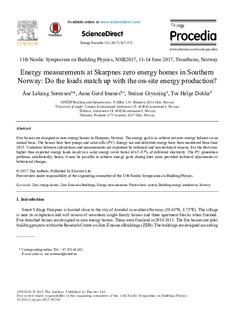| dc.contributor.author | Sørensen, Åse Lekang | |
| dc.contributor.author | Imenes, Anne Gerd | |
| dc.contributor.author | Grynning, Steinar | |
| dc.contributor.author | Dokka, Tor Helge | |
| dc.date.accessioned | 2017-10-26T06:54:53Z | |
| dc.date.available | 2017-10-26T06:54:53Z | |
| dc.date.created | 2017-10-19T09:45:24Z | |
| dc.date.issued | 2017 | |
| dc.identifier.citation | Energy Procedia. 2017, 132 567-573. | nb_NO |
| dc.identifier.issn | 1876-6102 | |
| dc.identifier.uri | http://hdl.handle.net/11250/2462227 | |
| dc.description.abstract | Five houses are designed as zero-energy homes in Skarpnes, Norway. The energy goal is to achieve net zero-energy balance on an annual basis. The houses have heat pumps and solar cells (PV). Energy use and delivered energy have been monitored from June 2015. Variations between calculations and measurements are explained by technical and non-technical reasons. For the first year, higher than expected energy loads result in a solar energy cover factor of 65–87% of delivered electricity. The PV generation performs satisfactorily, hence, it may be possible to achieve energy goals during later years provided technical adjustments or behavioral changes. | nb_NO |
| dc.description.sponsorship | Acknowledgements. This report has been written within the Research Centre on Zero Emission Buildings (ZEB), the project EBLE "Evaluation of Buildings with Low Energy-consumption" and the project “Electricity Usage in Smart Village Skarpnes”. The authors gratefully acknowledge the support from the Research Council of Norway and all the partners in ZEB and the two projects. For this paper, especially contributions from Agder Energi Nett, Scanmatic, Siv Ing Øivind B Berntsen, Skanska and the house-owners at Skarpnes are acknowledged. | nb_NO |
| dc.language.iso | eng | nb_NO |
| dc.publisher | Elsevier Ltd. | nb_NO |
| dc.rights | Attribution-NonCommercial-NoDerivatives 4.0 Internasjonal | * |
| dc.rights.uri | http://creativecommons.org/licenses/by-nc-nd/4.0/deed.no | * |
| dc.subject | Bygninger energisimuleringer | nb_NO |
| dc.subject | Building energy simulations | nb_NO |
| dc.subject | Energimålinger | nb_NO |
| dc.subject | Energy measurements | nb_NO |
| dc.subject | Null energibygg | nb_NO |
| dc.subject | Zero energy buildings | nb_NO |
| dc.subject | Fotovoltaisk system | nb_NO |
| dc.subject | Photovolatic system | nb_NO |
| dc.subject | Zero energy homes | nb_NO |
| dc.subject | Zero emission building; ZEB | nb_NO |
| dc.subject | Norway | nb_NO |
| dc.title | Energy measurements at Skarpnes zero energy homes in Southern Norway: Do the loads match up with the on-site energy production? | nb_NO |
| dc.type | Journal article | nb_NO |
| dc.type | Peer reviewed | nb_NO |
| dc.description.version | publishedVersion | nb_NO |
| dc.subject.nsi | VDP::Teknologi: 500 | nb_NO |
| dc.subject.nsi | VDP::Technology: 500 | nb_NO |
| dc.source.pagenumber | 567-573 | nb_NO |
| dc.source.volume | 132 | nb_NO |
| dc.source.journal | Energy Procedia | nb_NO |
| dc.identifier.doi | 10.1016/j.egypro.2017.09.743 | |
| dc.identifier.cristin | 1505788 | |
| dc.relation.project | Norges forskningsråd: 193830 | nb_NO |
| dc.relation.project | Norges forskningsråd: 226139 | nb_NO |
| cristin.unitcode | 7401,30,20,0 | |
| cristin.unitcode | 7401,30,40,0 | |
| cristin.unitname | Bygninger og installasjoner | |
| cristin.unitname | Arkitektur, byggematerialer og konstruksjoner | |
| cristin.ispublished | true | |
| cristin.fulltext | original | |
| cristin.qualitycode | 1 | |

